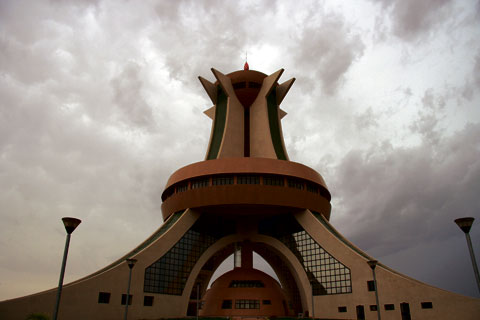Architect Antoni Folkers believes there is something oddly homogonous about African architecture. He defended his thesis on modern architecture in Africa earlier this month.
Ever since Dr Antoni Folkers was employed by an architects firm in Tanzania in the late 1980s, he has roamed the continent building homes, hospitals and schools. In his thesis, hard-covered with nice illustrations, he describes his experiences in Africa during the 25 years he has worked there.
African architecture. That’s a very broad topic. How can one pretend to cover the whole of ‘African Architecture’? “Of course that’s impossible,” says Folkers, who hears this question a lot. “But there are certain architectural expressions that you see all over the continent, which for me justifies the title of the book. There is something oddly homogonous about African architecture. Or better yet, I should say, there are certain families of African architecture that are very similar.”
Folkers opens his book and shows a drawing he made of a fictive street inspired by what he saw in East Africa, where he started his career. The drawing, showing a few houses with roofs of corrugated iron and walls made of concrete blocks, could be anywhere in Africa. “When I showed this drawing during a meeting in Ghana, people said they knew the place,” the architect recalls, laughing.
Corrugated iron and concrete blocks are seen everywhere in Africa, yet this is also true for places elsewhere in the world. “Africans however always add something extra to their buildings, something symbolic,” Folkers says, while leafing through his book. He stops at a picture of a hut painted in the colors of the South African flag. “Take this image of a house in Cape Town for instance. This is what we call shack chic. The house is hanging on threads. But what is important here is the message.”
Symbolism is very important in modern African architecture as well. It’s more important than functionality, according to Folkers. “The developers want to say something. It doesn’t matter that people will have to sit in a room with no windows as a consequence of that symbolism,” he explains while showing a picture of a building with huge circles that symbolize the sun.
Though Folkers’ main motive while working in Africa has been to develop affordable but qualitative buildings, such as schools and hospitals, he once let himself go completely when asked to finish a half-built cathedral. “We put a golden crown on top of the roof,” he laughs. “That wasn’t very functional. At the faculty of Architecture in Delft they would have given me slap on the head for that.”
Though Folkers likes to sum up the disadvantages associated with the symbolism he sees in many buildings, he also believes that ignoring it is a mistake, a mistake which many Western architects have made.
“For years Africa has been an experimental garden for Western architects. In the 1980s we were convinced that Africa needed adapted technologies. Since concrete apartment buildings would never be affordable for the majority of Africans, we thought we had to develop new materials, like loam-mixed with cement. We started experimenting with dome-shaped houses made of that material. I was a great supporter of this movement.
“We have learnt the hard way. You must be very careful with these kind of things. Africans have other aspirations. Though the domes of loam insulated very well against the heat, the Africans didn’t want them. They’d never heard of domes. They prefer modern materials. As an architect it’s better to link up with what’s going on. So it’s better for instance to celebrate corrugated iron. There are people that make suspended roofs of that material. They make fabulous things with simple means.”
Metakids is een stichting die zich inzet voor onderzoek naar stofwisselingsziekten bij kinderen. Vooral zaterdag ligt het accent op Metakids. Er zijn tal van activiteiten om aandacht te vestigen op de problematiek van kinderen met stofwisselingsziekten en om geld voor onderzoek in te zamelen.
Er is onder meer een speciale wedstrijd voor bedrijven waarvan de opbrengst naar Metakids gaat. Die wedstrijd gaat om 12.45 uur van start bij Lijm en Cultuur aan de Rotterdamseweg. Het startschot wordt gelost door voormalig nieuwslezeres Debby Petter. Op het terrein van Proteus-Eretes aan de Kanaalweg 362A is onder meer een kraam van Metakids.
Verder sprinten zaterdag ongeveer 70 boten over 450 meter. De eerste start is om 8.30 uur, de laatste om 18.00 uur. Zondag staan races over 4500 meter op het programma. Er wordt van vanaf Overschie naar de Kruithuisbrug gevaren. De wedstrijden duren van ongeveer 9.30 uur tot 18.45 uur. Er staan punten op het spel voor onder andere de C4-en, Clubdubbelvieren én de Kruithuisbokaal.
Meer informatie over Metakids staat op de site van de stichting. Voor wedstrijdinformatie zie de site van Proteus-Eretes.



Comments are closed.